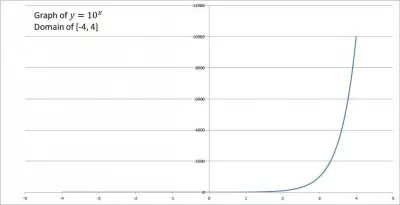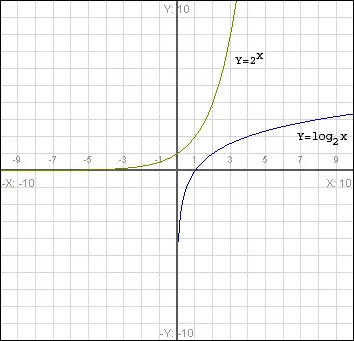A logarithm is just another way to talk about exponents. When we talk about logs, we are interested in the base, the power (exponent), and the result – and also whether they can be negative or not.
So, can a log be negative? The output of a log function (the exponent) can be negative. However, the input (argument) and base of a log function cannot be negative (unless we want to consider complex numbers).
A common case where a negative log can occur is when we are dealing with a positive integer base (a whole number greater than 1) and an input that is a number between 0 and 1.
In this article, we’ll talk about when logs can be negative. We’ll also answer some common questions about negative numbers as they relate to logarithms.
Let’s get started.
Can A Log Be Negative?
The output of a log function (also known as the exponent) can be negative in certain cases. For example:
- log2(0.5) = -1
We can confirm this by converting to exponential form to get:
- 2-1 = 1 / 2 = 0.5
However, the input (argument) and the base of a log function cannot be negative (unless we want to deal with complex numbers).
What Does A Negative Log Mean?
A negative log means that we will use a negative exponent (power) when we convert from log form to exponential form. Remember that a negative exponent means that we are dividing by a number rather than multiplying.
For example:
- 5-2 = 1 / 52 = 1 / 25
That is, we are dividing by 25 instead of multiplying by 25. (Remember that the reciprocal of a number is just that number raised to the power of -1).
As a reminder, here is the way to convert between log form and exponent form:
- logB(N) = E <–> BE = N
The variables in these equations stand for:
- B = the base of the logarithm (and also the base of the exponential form).
- E = the exponent (or output) of the logarithm (and also the power that the base is raised to in exponential form).
- N = the number (or argument) of the logarithm. This is the value that we get when we raise the base to the exponent.
Let’s look at some examples to help the concept sink in.
Negative Logarithm: Example 1
A common case where a negative log (E) can occur is when the base (B) is a positive integer (a whole number greater than 1) and the input (N) is a number between 0 and 1.
Let’s look at the case where B = 3 and N = 1/3. Then we want to solve log form for E:
- log3(1/3) = E
We can convert from log form to exponential form with B = 3 and N = 1/3 to get:
- 3E = 1 / 3
Remember that 1/3 is really 3 raised to the power of -1, so:
- 3E = 3-1
Since the bases on both sides of the equation are the same (B = 3), that means the exponents are equal as well. Thus, E = -1 in this case, and so we have a negative logarithm.
Negative Logarithm: Example 2
A log with a base of 10 is often used in science (for example, when doing pH calculations in chemistry).
Taking the log of a small decimal number will sometimes lead to a negative log (exponent):
- log10(0.001)
- = log10(1 / 1000)
- = log10(1 / 103)
- = log10(10-3)
- = -3
Another application of base 10 that you may be familiar with is measuring mass (or weight):
- A kilogram is 1000 grams (10 to the power of 3)
- A milligram is 0.001 grams (10 to the power of -3)
- A microgram is 0.000001 grams (10 to the power of -6).
Can You Take A Log Of A Negative Number?
You cannot take the log of a negative number (unless you want to deal with complex numbers). Once again, converting from log form to exponential form will help us to see why this is the case.
For example, let’s say you wanted to take the log of -100, using a base of 10. So, we want to solve this log form equation for E:
- log10(-100) = E
Converting from log form to exponential form, we get:
- 10E = -100
The base is 10 (which is positive), while the input is -100 (which is negative). This means that there is no real number we can substitute for E to get a result of -100 (any real number we plug in for E will give us a positive value).
You can see this more easily in the graph below – the y values for the function y = 10x never go below zero.

Of course, if you want to take the log of a negative number and work with complex numbers, you can certainly do so. Stanford has a page explaining logarithms of negative (and imaginary!) numbers here.
Can Logs Have A Negative Base?
A log cannot have a negative base (unless you want to deal with complex numbers). Even then, the log function will not be continuous.
Can The Solution Of A Log Be Negative?
The solution of a log equation can be negative in certain cases. Let’s look at some examples to see how this happens.
Negative Solution To A Log Equation: Example 1
Consider the log equation:
- log3(x2) = 4
Converting to exponential form, we get:
- 34 = x2
- 81 = x2
Taking the square root on both sides gives us two solutions: a positive number and a negative number. The two solutions are x = +9 and x = -9.
Note: be careful! There appears to be another way to approach this problem, but we will “miss” the negative solution.
If we use the rule:
- logB(xA) = AlogB(x)
In this case, we would get:
- 2log3(x) = 4
- log3(x) = 2
- 32 = x
This gives the solution of x = 9, but it misses the solution of x = -9. But why does this method miss the 2nd solution? The reason it misses the negative solution is that the rule
- logB(xA) = AlogB(x)
is only valid for x > 0.
The moral of the story is this: always check your assumptions and check your conditions before using an equation or theorem!
Negative Solution To A Log Equation: Example 2
Consider the log equation:
- log2(x2 – x – 12) = 3
Converting to exponential form gives us:
- 23 = x2 – x – 12
- 8 = x2 – x – 12
- 0 = x2 – x – 20
- 0 = (x + 4)(x – 5)
The solutions are x = -4 and x = 5. If you plug both values back into the original log equation, you will see that both work – there is no problem with any undefined input.
Can Log Be Zero?
A log can be zero if the input (argument) to the log function is 1 (this is true for any valid base). We can see this easily by converting from log form to exponential form:
- logB(N) = 0
- B0 = N
This means N = 1, since any base raised to the power of zero is 1.
When Is Log Undefined?
The log function is undefined when the argument is zero or negative. As mentioned earlier, you can use a negative argument in a log function if you are working with complex numbers.
However, an argument of zero never makes sense in a log function. Once again, we’ll convert from log form to exponential form to see why:
- log2(0) = E
Converting to exponential form, we get:
- 2E = 0
There is no number we can substitute for E to make this equation true. Any real value of E we choose will give us a positive number (you can see the graph of y = 2x below: it is the top green curve).

Even if we choose a large negative number, the result will be close to zero – but it will never have a value of exactly zero.
So, in short, you cannot take the log of zero: the natural log of zero (along with the log of zero for any other base) is undefined.
Conclusion
Now you know a little more about logarithms and how they interact with negative numbers. You also know the key equation for converting between log form and exponential form, which is often helpful when working with logarithms.
You can learn how to change the base of a logarithm here.
Logarithmic functions are the inverse to exponential functions, which you can learn more about here.
You can learn more about graphing a function and its inverse in my article here.
You might also want to read my article on common questions about logarithmic functions and my article on how to find the base of a logarithm.
I hope you found this article helpful. If so, please share it with someone who can use the information.
Don’t forget to subscribe to my YouTube channel & get updates on new math videos!
~Jonathon

